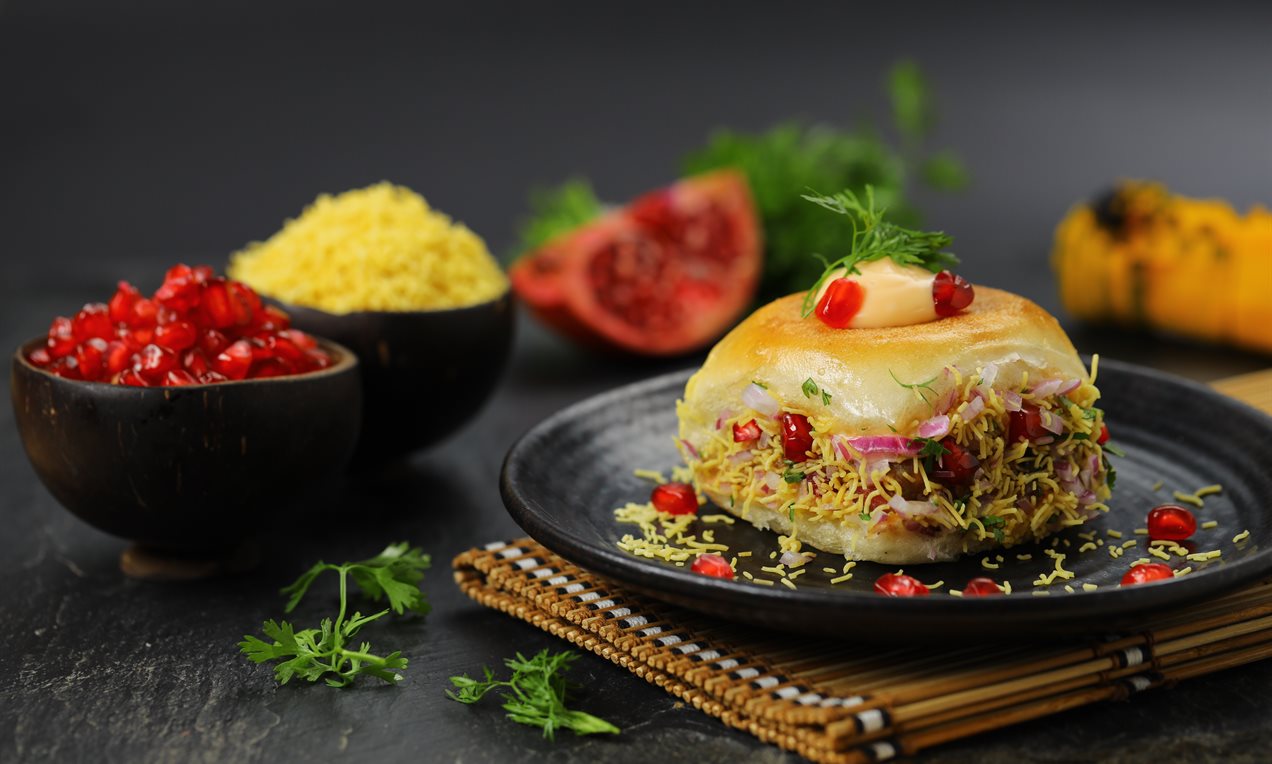Cuisine
Gujarat Thali
Gujarati Thali
A Gujarati thali typically comprises of one or two steamed or fried snacks called farsans, a green vegetable, a tuber or a gourd shaak (shaaks are main courses with vegetables and spices mixed together into a curry or a spicy dry dish), a kathol (braised pulses like beans, chickpea or dry peas), one or more yogurt dishes like dahi, kadhi (yogurt and pulses soup), raita or sweet shrikhand, rice or khichdi, daal usually toor dal, and sweets like halwas, basundi or shrikhand. Accompaniments include sweet, sour and spicy chutneys, pickles, ghee and a salad of chopped vegetables served raw or may be steamed in spices.
Much detailing goes into creating a balance of tastes and textures – you could have coarse, grainy, granular, smooth, uniform, dry and wet dishes on the same platter, the sweetness, bitterness, sourness and heat of each main course would vary between dishes, and the thali has more colours than a rainbow – the yellow of turmeric, the whiteness of dairy products, the redness of tomatoes, the green of leafy vegetables, the brown of pulses, and the colours of various spices, relishes and salad vegetables, are harmoniously part of a single thali.
The breads eaten with a thali would include thick and coarse bajra rotla, thin unleavened wheat rotlis, thick and crisp whole wheat flour rotis called Bhakris, parathas, savoury griddle bread called the thepla, deep-fried puris, among others. There are many variations like methi thepla or masala puri within these breads. As Gujaratis are globe-trotters, with a large Gujarati Diaspora overseas and around India as well as being great travellers on holiday or pilgrimage around the world, there are many Gujarati farsans, snacks and mini-meals that are designed to travel and keep well – for instance Khakhras are crisp wafer-like rotis made from wheat, cornflour or lentils that can be carried and eaten with vegetables or accompaniments or dhebras made from a mix of flours can travel better than rotlis.
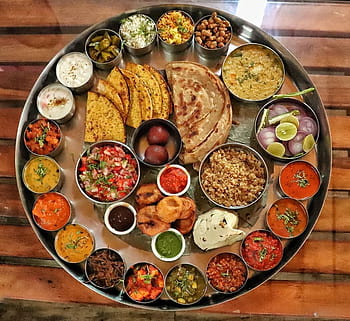
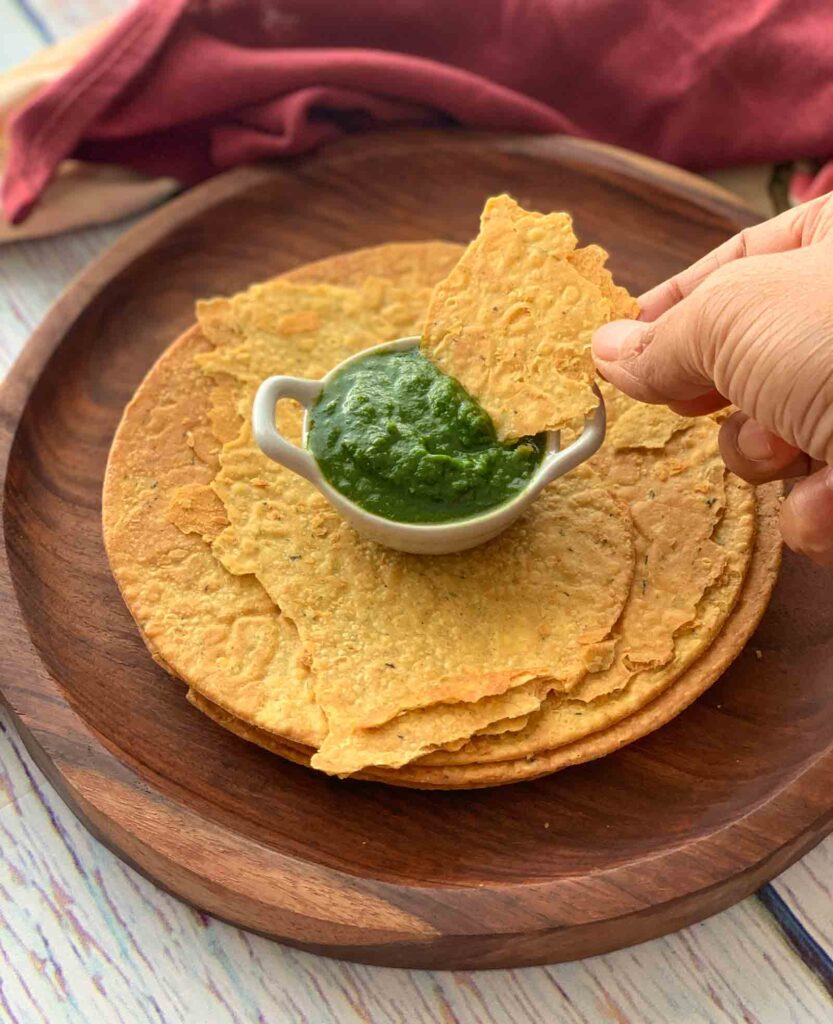
Khakhra
This delicious roasted Khakhra and Bhakri are best for consumption at any time of the day. Moreover, you could munch on them till your heart’s content. Savour the wholesome goodness of healthy ingredients in these roasted-to-perfection crisps. Aren’t these the perfect replacement for fried chips? Packed with good taste, health and break away with the best snap. Rahe Gujarati Snacks is always concerned about …
Khakhra: This thin, papad-like snack is most commonly made from a mixture of wheat flour, mat bean, and oil. Flavours such as methi, jeera, pudina and ajwain are common, and new ones like dosa and chaat are gaining popularity. Not very well known is the mungdi, a sweet variant of the khakhra.
Khakhra is a thin cracker made with moth beans and wheat flour as its basic, core ingredients. A bunch of chosen spices, a bit of oil and these non-fried, yummy crisps are ready to relish. Khakhras are a very popular accompaniment in breakfast and also as light evening snacks. They are not just light and tasty, but healthy as well. There are a whole lot of different flavours in these delicious, thin tortilla-like crisps. Methi, Masala being the most common ones; one can now easily find an array of creative and exciting flavours such as Pav Bhaji, Pani Puri, Pizza, Garlic Bread, Chaat Masala, Manchurian, Instant Noodles, Vada Pav and a lot more! As unbelievable as this sounds, these flavours of Khakhras actually exist!
Fafda
The Gujarati snack Fafda might sound funny when spoken, but it surely doesn’t taste funny. In fact, it tastes fab. And why shouldn’t it also? It is a crispy, crunchy fried snack. Thus, is highly addictive and scrumptious just like any other fried Indian snack. The Fafda Recipe is a simple one and the main ingredient of this preparation is gram flour (besan). My version is also laced with the flavors of carom seeds (ajwain) and black pepper (kali miri). So, I would actually call it better than what’s available in the markets.
Fafda: The crisp, yellow snack is a festival favourite, especially during Dussehra. The batter, made of gram flour, carom seeds and oil, is rolled out into cylindrical shapes and deep-fried till crisp. Served with deep-fried chillies, papaya sambaro, and besan chutney, it’s a much-loved breakfast treat.
If there’s one sought-after food duo in Gujarati cuisine, it is the Fafda and Jalebi. I mean jalebi, otherwise also is a much-loved sweet snack pan India.
But when it comes to a yummy sweet and salty combination, particularly in Gujarati food, this is what you should feed yourself.
Both these also make for an amazing breakfast choice as well as popular treats during festivals like Navratri, Dussehra and Diwali.
Basically, Fafda is a fried rectangular snack, primarily made with gram flour or chickpea flour (besan). Since this is the main ingredient in the Fafda Recipe, the snack is also yellow in color.

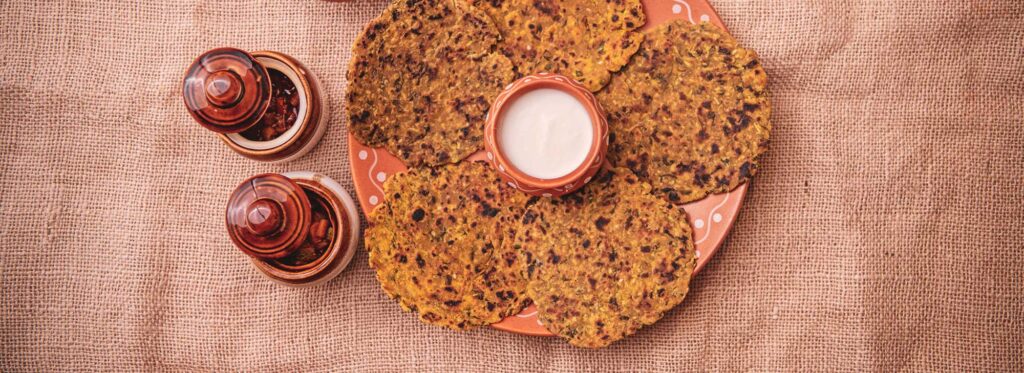
Thepla
This soft flatbread is part of the main meal, but is often consumed as breakfast or a snack with a hot beverage. Typically made with wheat flour, gram flour, fenugreek leaves, and other spices, the flatbread is liberally dotted with sesame seeds. Gujaratis enjoy their thepla with dahi, chhundo (sweet mango pickle), and red garlic chutney. A smattering of every flavour! Variants use dudhi (bottle gourd) and mooli (radish).
No Gujarati journeys, picnics, foreign trips or even business trips are complete without this ubiquitous snack. Made from gram flour, whole wheat flour, fresh fenugreek leaves and spices, these flatbreads are healthy snacking options with a long shelf life. Usually served piping hot with fresh curd, pickles or chundo, they make wholesome meals. When accompanied by a cup of steaming hot tea, they also make a sumptuous breakfast or a great snack during the monsoon. Although the methi (fenugreek) ones are the most common, other varieties include palak (spinach), amaranth or muli (raddish) theplas-specially recommended for fussy eaters.
Ghughra
Ghugra or Gujiya is another festive Gujarati snack. It is also known as Karanji in various parts of India. This one is prepared using a refined flour dough that is stuffed with a filling before deep frying. The filling is made using roasted semolina or rawa, dry fruits such as almonds, raisins; grated coconut, cardamom powder and sugar. It is the style of wrapping the filling in the tortilla that is quite unique and interesting. They are formed in a half-moon shape, where the round edge is twisted to create a pattern.
Ghugra or Gujiya is another festive Gujarati snack. It is also known as Karanji in various parts of India. This one is prepared using a refined flour dough that is stuffed with a filling before deep frying. The filling is made using roasted semolina or rawa, dry fruits such as almonds, raisins; grated coconut, cardamom powder and sugar. It is the style of wrapping the filling in the tortilla that is quite unique and interesting. They are formed in a half-moon shape, where the round edge is twisted to create a pattern.
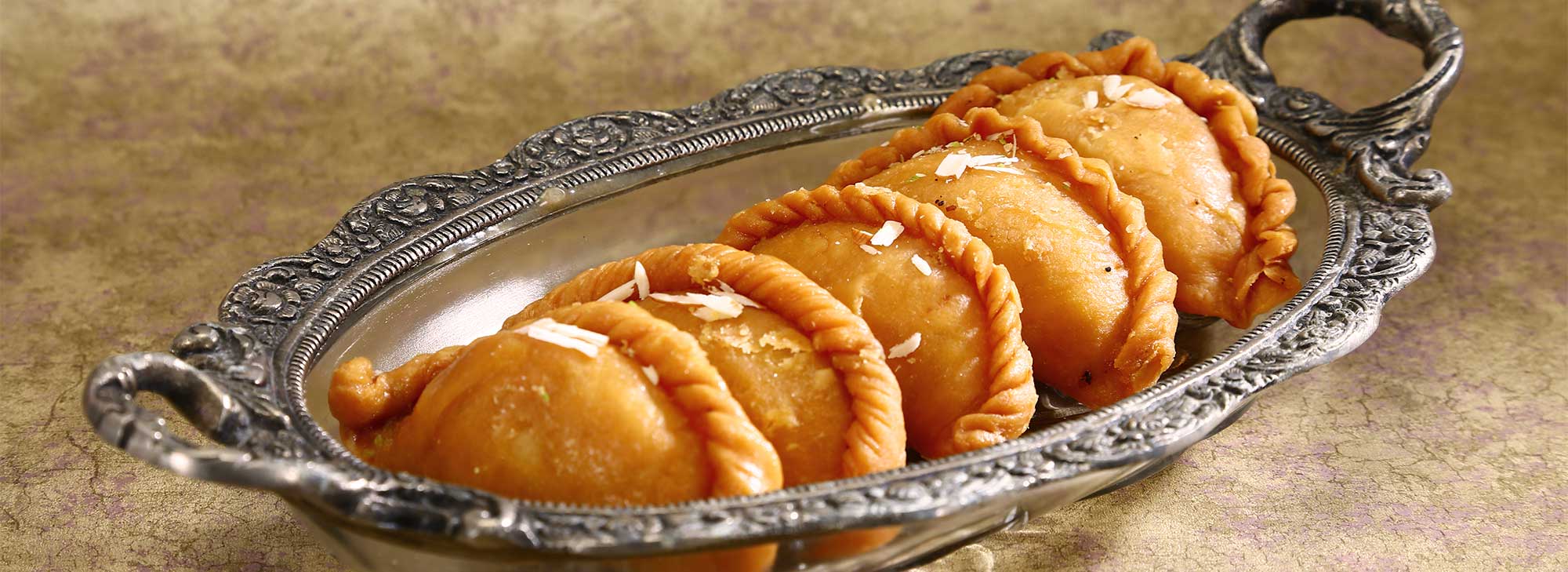
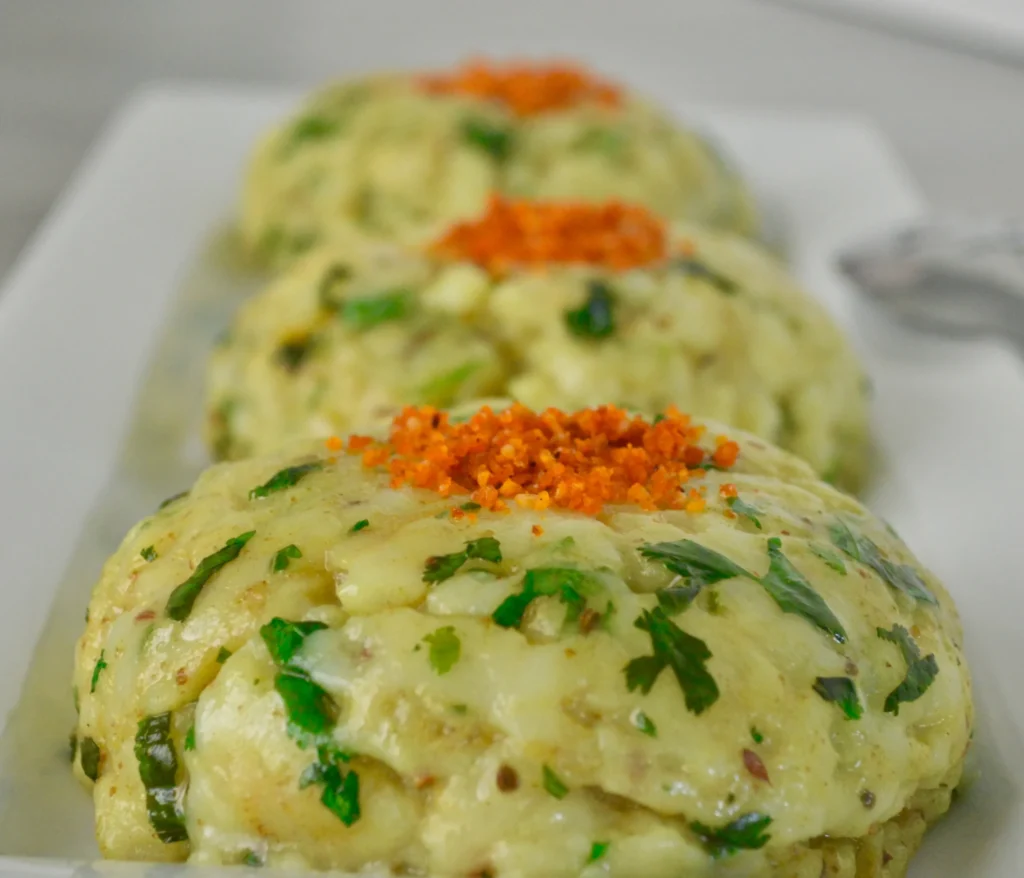
Khichu
Khichu or Khichiyu is a dough for making papad/papadi, however, owing to its taste it is also consumed as Farsan (snack/side dish). It is made from rice flour, though, a few other flours are also used. The snack is prepared by cooking flour in water like porridge with cumin seeds, carom seeds, salt and an alkaline salt/baking soda known as Papad Khar, and then steaming the lump. It is often served with oil and chilli powder. The name khichiyu or khichu is derived from the ductile nature of the dough.
What started off as a dough for making the yummy khichiya papads, itself ended up as a delicious dish. Commonly found across the food stalls in many Dandiya and garba venues during Navratri, it is a dough made from rice flour added to boiling water alongside green chillies, cumin seeds, and sesame seeds, then cooked in steam and seasoned with groundnut oil. The groundnut oil seasoning gives a gourmet touch to this simple, wholesome dish. Although it is commonly prepared using the rice flour, other variants include usage of wheat flour, nachani (ragi) flour, bajri flour and jowar flour. Its warm, soft and gooey texture makes it a great evening snack during the colder months, loved by children and adults alike.
Handvo
Traditionally prepared over charcoal or in a pressure cooker, handvo is essentially a savoury cake. To prepare handvo, a batter of lentils and rice is prepared and fermented overnight, and then baked. They are sometimes also pan-fried to make them crispy and golden, and the sesame seed seasoning makes them just irresistible! These nutritious pan-fried or baked lentil cakes are a very popular one-dish meal in Gujarati households. Like most other Gujarati snacks, they are best enjoyed with tangy green chutney and a hot cuppa.
Handvo is a traditional Gujarati dish that dates back to the 15th century. It is believed to have originated in the state of Gujarat, India, where it was a staple food for farmers and laborers.
Name: The name “Handvo” is derived from the Gujarati word “handwa”, which means “cake” or “flatbread”.
Handvo is popular not only in Gujarat but also in other parts of India, including Maharashtra and Rajasthan. Each region has its own variation of handvo, with different ingredients and spices.
Handvo is an important part of Gujarati cuisine, particularly during festivals such as Navratri and Diwali. It is often served as a snack or appetizer during these celebrations.
Handvo is a nutritious food that is high in protein, fiber, and vitamins. The chickpea flour used in the batter provides a good source of protein, while the rice flour adds fiber and carbohydrates.
Handvo is an important part of Gujarati culture and is often served at family gatherings and special occasions. It is a symbol of hospitality and is often offered to guests as a sign of respect.
Handvo is an eco-friendly food that uses locally sourced ingredients and minimal oil. The dish can be made in large quantities and stored for several days, making it a sustainable option for busy households.
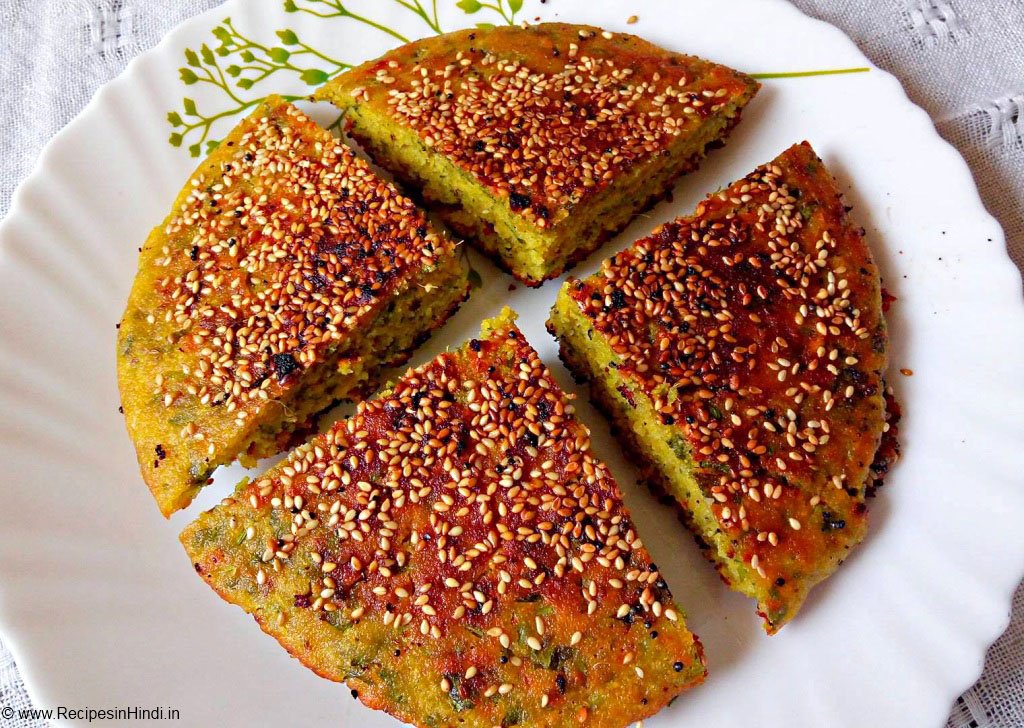
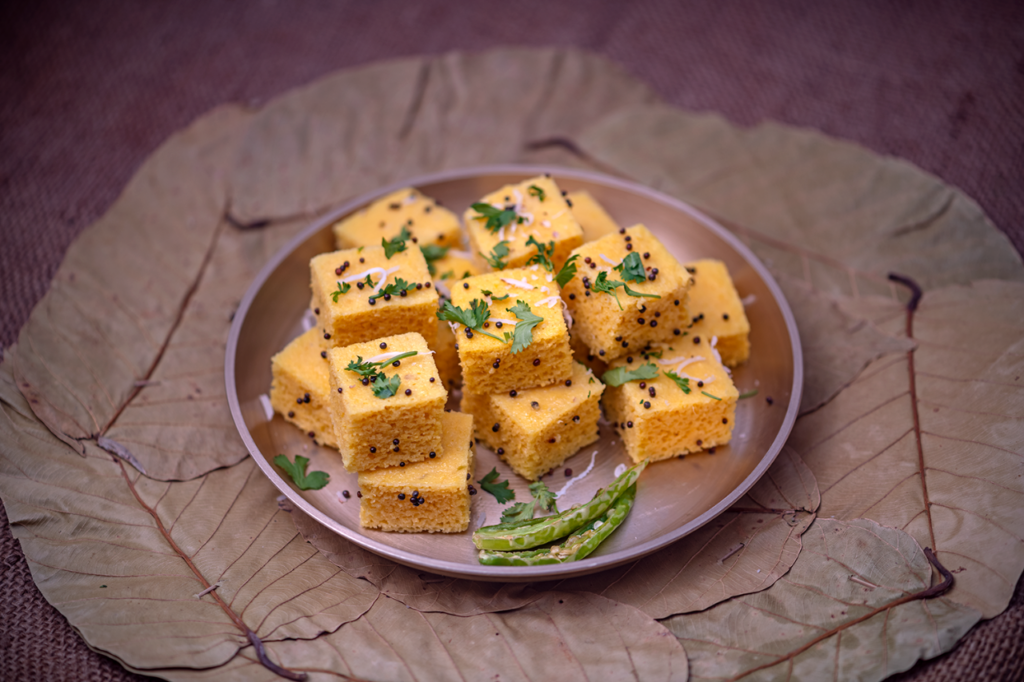
Khaman
Khaman is probably the most recognized Gujarati appetizer or snack. This moist and delicious savory cake is a must for a Gujarati feast but don’t get it confused with Dhokla. A little bit of pre-planning is needed for this traditional khaman recipe but it’s worth every minute. Try it for your next party or get together!
A tasty and healthy steamed snack made from freshly ground lentils and chickpea flour, it is very similar to its humble cousin, the world-famous -dhokla. To prepare the khaman, the khaman flour mix is boiled along with turmeric, salt and baking soda to make it light and fluffy. It is then cut up into cubes and usually garnished with mustard seeds, coriander leaves, sev and chopped onions. Traditionally served on a large green leaf called the Kesuda, the modern, urban version is served in newspapers in farsan (snack) shops with tangy chutneys and several pieces of green chillies. Popular adaptations of the khaman include Ameri khaman (mashed up khaman garnished with sev and pomegranate), Nylon khaman (softer and fast-cooking khaman) and Masala khaman (khaman served with hot and spicy chilly powder)
Aamras
Aamras is a popular Gujarati dessert that celebrates the sweetness of summer harvests. It is a velvety mango pudding that is enjoyed as a dessert or paired with savory dishes. The dish is a timeless classic in Gujarati cuisine, showcasing the artistry of flavor blending and the region’s rich gastronomic heritage.
Aamras puri or ras puri is a traditional Gujarati/Maharashtrian dish and it is a combination of liquified mango pulp, some spices and puris.
Mango is a king of all the fruits, basically It is the only fruit which has vast variations types. It is a stone fruit that is very juicy.
In Hindi language it is known as “Aam” whereas, It’s botanical name is Magnifera indica.
Mango was first grown in the Indian subcontinent, later on, other countries also starts cultivating mango plant.
In Philippines, it is known as ‘king of fruits’ and in Bangladesh, it has been given a status of National tree.
India produces more than 1400 varieties of mangoes and it contributes to 41% of the World’s total mango production.
Apart from India, China and Thailand are the major producers of mango.
Srinivaspur, in Kolar, Karnataka is known as the “Mango city” of India and it produces more than 63 species of Mango.
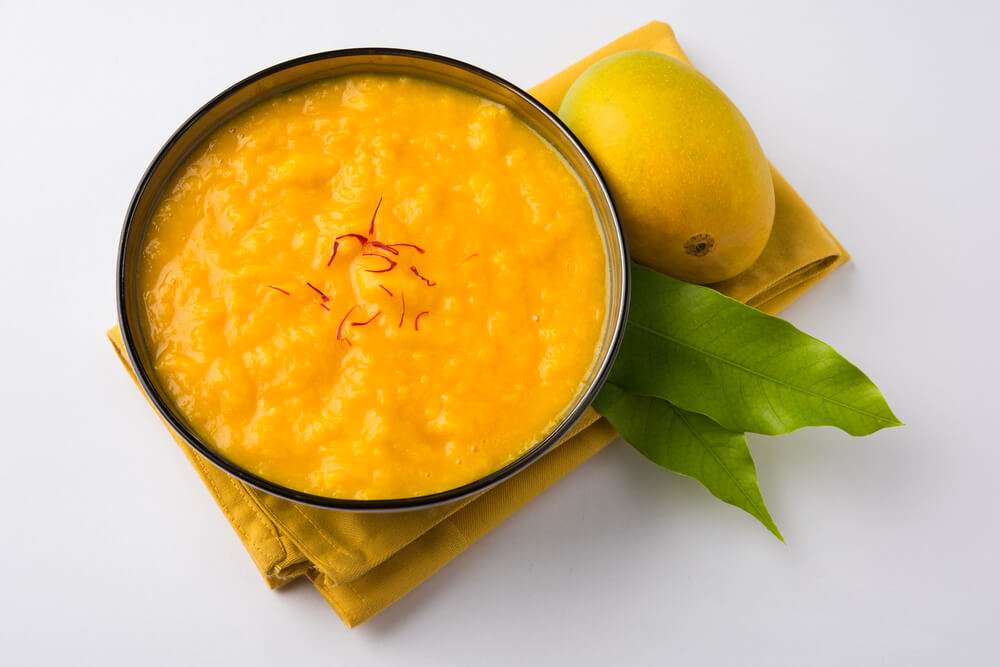
Khandvi
Khandvi is a popular Gujarati snack that is loved by people of all ages. It is a soft, melt-in-the-mouth, spiced and seasoned gram flour roll that is typically served with a tempering of sesame seeds, mustard seeds, and curry leaves.
Khandvi is a healthy, guilt free savory snack the whole family will enjoy. It is popular in Gujarati cuisine, also known as Dahi Vadi. In Maharashtrian cuisine, this is called Surali Vadi or Suralichi Wadi.
Khandvi needs very basic ingredients, which you might already have in your pantry and refrigerator. It is made with gram flour (besan), yogurt, salt, ginger paste, turmeric powder tempered with mustard seeds, green chili, sesame seeds, and garnished with grated coconut and cilantro.
Thin layers of gram flour cooked with buttermilk and rolled up in mushy goodness, seasoned with sautéed sesame seeds and a few other spices, that’s khandvi for you. The simple but aromatic garnishing of curry leaves, coriander, sautéed cumin, mustard and coconut makes it simply irresistible. Also called ‘suralichya wadya’ in Maharashtra, it is a popular snack among Gujaratis and Maharashtrians alike. Although loved by all, no one can deny that this dish is a little tricky to cook, especially getting the consistency of the batter right. Light on the stomach and pleasing on the tongue, khandvi can be a perfect breakfast item or a delectable evening snack.

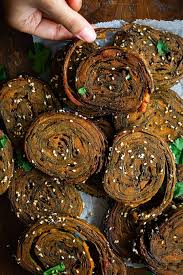
Patra
Patra is a traditional Gujarati dish made from colocasia leaves, also known as taro leaves or arbi ke patta. The leaves are cleaned, rolled, and stuffed with a gram flour batter prepared with spices, tamarind, and jaggery. The rolls are then steamed and cut into small pinwheels, which are crispy on the outside and soft on the inside.
The Gujarati Patras also known as Alu Vadi’s is a delicious preparation which is made using colocasia leaves that has a sweet and tangy gram flour mixture spread on them and rolled in a special way to form a pinwheel.
Traditionally, Patra is made from colocasia leaves and many a times they are seasonal and are not readily available in most parts of India or even parts of the world. I used to find it hard to make this delicacy during my stay in Boston and my mother in law gave me a brilliant idea of using large spinach leaves instead that were available in abundance in the market. I hope you enjoy making this delicacy as much as I have enjoyed sharing this family favourite.
Serve Gujarati Patra Recipe as a dish along with your Gujarati meal of Gujarati Kadhi, Bhindi Aloo and Phulkas.
Gathiya
Gathiya is a tea-time snack. It is primarily made of besan or gram flour. It is like a thicker sev, however, there are a few notable differences. There are usually two kinds of Gathiya: Tikha (spicy) Gathiya and regular Gathiya. The difference is in terms of the spices used in the dough. The regular one has carom seeds, salt, turmeric, soda bicarb, and a dash of oil. Tikha has additional spices like black pepper and red chilli powder. The dough is then made to pass through a mould, making its strands, straight into the oil for deep frying. The end result is not crunchy, but a bit soft. Must try, for sure!
Gathiya is a popular Gujarati snack that is loved by people of all ages. It is a crunchy and savory snack made from gram flour (besan) and a blend of spices. Here are some key details about Gathiya:
Recipe Variations
There are several variations of Gathiya recipes, including:
- Makhaniya Gathiya: A classic recipe that uses gram flour, spices, and a special technique to achieve the perfect balance of crunchiness and softness.
- Tikha Gathiya: A spicy version of Gathiya that uses red chili powder to give it an extra kick.
- Champakali Gathiya: A variation that uses chickpea flour instead of gram flour.
- Bhavnagari Gathiya: A popular version from the Bhavnagar region of Gujarat.
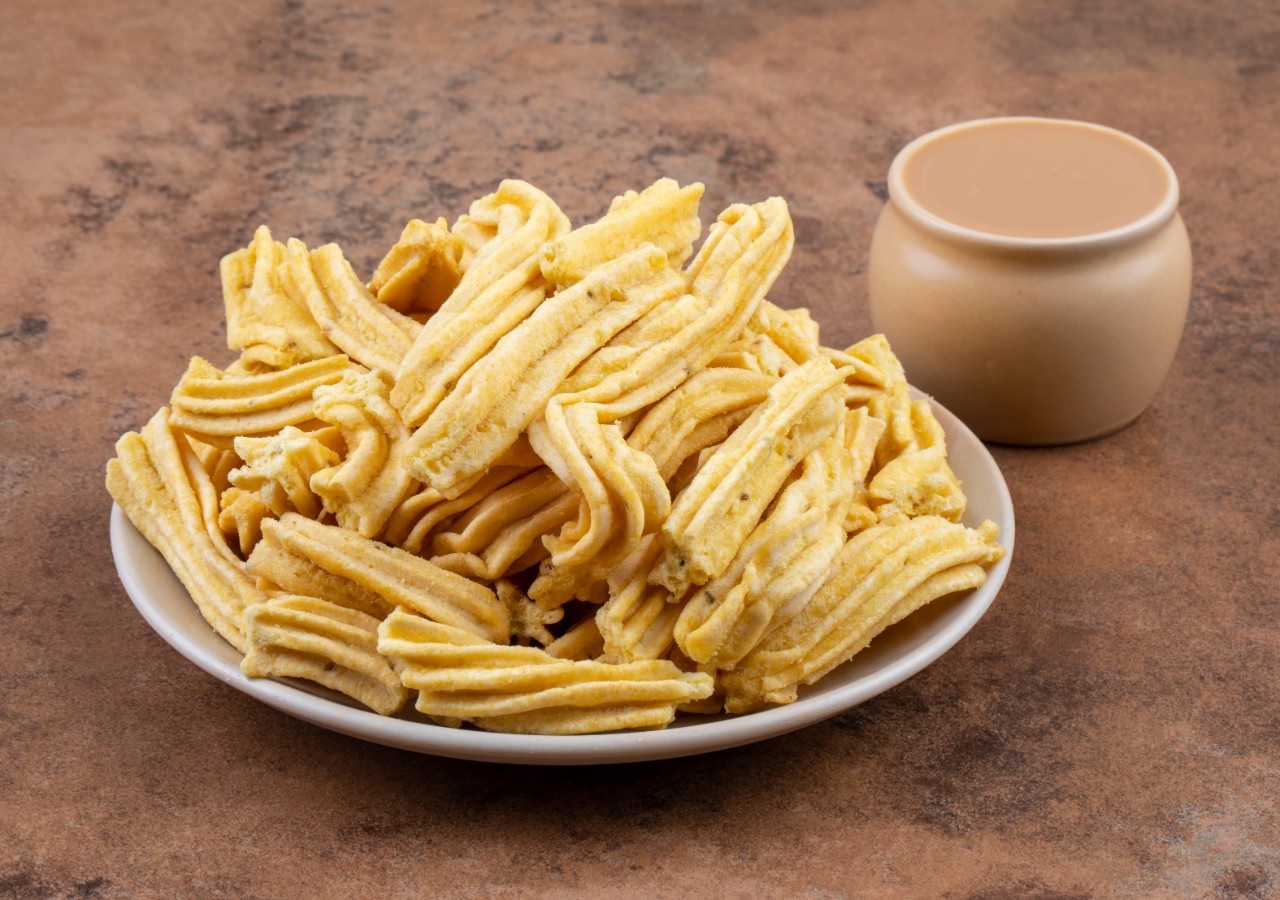
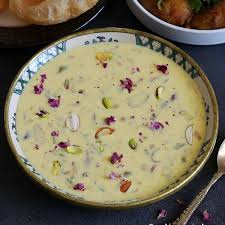
Basundi
You might believe that Gujarat is primarily known for its sweet treats, and you’d be correct. Basundi is a dessert similar to Rabdi, often served during special celebrations in Gujarat. It’s made by simmering condensed milk and mixing grapes, apples, and other delightful flavours. If you’re familiar with Rabdi from North India or other regions, Basundi is quite similar. Its flavours are unique and more enticing than the usual Rabdi and Falooda.
Basundi is a popular dessert in Western India, particularly in Gujarat. It is a sweet, creamy, and flavorful dish made with slow-cooked milk, sugar, and spices. Here are some key details about Basundi:
- Preparation: Basundi is made by simmering whole milk on low heat until it is reduced to half its original quantity. Sugar, cardamom, and saffron are added to the milk to give it a sweet and aromatic flavor.
- Flavor Profile: The dish has a rich, creamy texture and a sweet flavor with a hint of spices. The cardamom and saffron add a unique and enticing aroma to the dish.
- Serving: Basundi is often served warm or at room temperature, garnished with chopped nuts and dried fruits. It is a popular dessert in Gujarat and is often served during special occasions and festivals.
- Variations: There are different styles of Basundi, including sitaphal (custard apple) Basundi and angoor Basundi (Basundi with smaller kinds of rasgullas).
- Similarities to Rabdi: Basundi is similar to Rabdi, a popular dessert in North India. Both dishes are made with milk, sugar, and spices, but Basundi has a thicker and creamier texture than Rabdi.
Overall, Basundi is a delicious and traditional Gujarati dessert that is perfect for special occasions and celebrations.
Dabeli
Dabeli can be considered the Gujarati equivalent of Mumbai’s Vada Pav. While their textures are similar, Dabeli boasts a distinctive taste. This Gujarati food is a popular street food from Kutch. It is often enjoyed with evening tea or by itself as a snack. Its buns are filled with sev, peanuts, chutney, pomegranate, Dabeli masala, and spices.
The word Dabeli refers to ‘pressed.’ It is a type of dish that is made using a mash potato mix that has spices, onions, tamarind chutney, coconut, some pomegranate seeds, peanuts coriander and boiled potatoes. This potato filling is placed between two bread buns and cooked on a Tawa with some oil. The buns are then pressed and flattened to make the Dabeli true to its name. It is a somewhat crunchy, savoury, flavourful fast food dish that one can grab and go.
